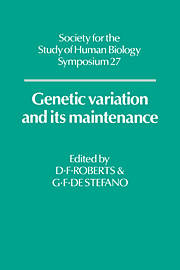Book contents
- Frontmatter
- Contents
- Preface
- Part I Genetic Diversity - Its Dimensions
- Genetic polymorphisms - a widening panorama
- Some implications of improved electrophoresis techniques for population genetics
- HLA variation in the tropics
- Chromosome polymorphism in humans
- Restriction fragment length polymorphisms in the human genome
- Nucleotide sequences, restriction maps, and human mitochondrial DNA diversity
- Mitochondrial DNA variation in eastern highlanders of Papua New Guinea
- The Contribution of polymorphisms in mtDNA to population genetic studies
- Part II Genetic Diversity - Its Origin and Maintenance
- GENETIC DIVERSITY - APPLICATIONS AND PROBLEMS OF COMPLEX CHARACTERS
- Index
Nucleotide sequences, restriction maps, and human mitochondrial DNA diversity
Published online by Cambridge University Press: 05 March 2012
- Frontmatter
- Contents
- Preface
- Part I Genetic Diversity - Its Dimensions
- Genetic polymorphisms - a widening panorama
- Some implications of improved electrophoresis techniques for population genetics
- HLA variation in the tropics
- Chromosome polymorphism in humans
- Restriction fragment length polymorphisms in the human genome
- Nucleotide sequences, restriction maps, and human mitochondrial DNA diversity
- Mitochondrial DNA variation in eastern highlanders of Papua New Guinea
- The Contribution of polymorphisms in mtDNA to population genetic studies
- Part II Genetic Diversity - Its Origin and Maintenance
- GENETIC DIVERSITY - APPLICATIONS AND PROBLEMS OF COMPLEX CHARACTERS
- Index
Summary
INTRODUCTION
A great deal has been learned in the last five years about the molecular basis of human mitochondrial DNA polymorphisms (Brown, 1980; Giles et al, 1980; Cann & Wilson, 1983; Greenberg et al, 1983; Johnson et al, 1983; Horai et al, 1984; Cann, Brown & Wilson, 1984). This new field has contributed to issues of mutation rates, DNA repair, and ageing or programmed cell death, topics important in human evolution no matter which population is studied. However, mitochondrial DNA (mtDNA) also carries the potential for unifying information on maternal lineages into convenient markers for phenotypic and organism diversity, where one is concerned with sexual selection, founding events, migration, admixture, and cultural revolutions. Some tropical populations by virtue of their relative isolation or historical accidents in contact with western Europeans, provide unique opportunities to study the human gene pool and how it responds in periods of cultural transition, particularly the female contribution to it.
This paper summarises information derived from the study of human mitochondrial polymorphisms on a worldwide basis. Some of the polymorphisms are private, some are cosmopolitan. The classification of these may depend simply on the level at which one works, i.e. DNA sequencing, high resolution restriction fragment mapping, or Southern blots of genomic DNA using purified mtDNA as a molecular probe. Knowledge is at the stage where one can begin to tailor the technology to the question asked. This may be as global as enquiring how reproductive strategies differ between males and females, or may be as limited as asking how many canoes eventually landed in Samoa.
- Type
- Chapter
- Information
- Genetic Variation and its Maintenance , pp. 77 - 86Publisher: Cambridge University PressPrint publication year: 1986

